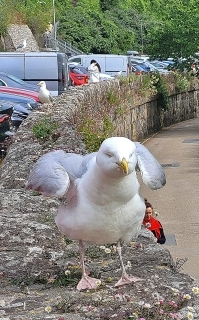Adam Yamey's Blog: YAMEY, page 46
July 11, 2024
Rain drops
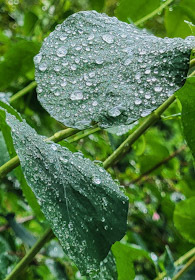
Drops of rain keep
Falling on my many green leaves
Don’t you see them now
July 10, 2024
Inspired by Claude Lorraine and Nicolas Poussin in Wiltshire and Somerset
WHEN I WAS a teenager, I made excursions – day trips – to places outside London with a small group of friends. Being too young to have driving licences, we had to rely on public transport. One place that we always wanted to get to is on the border between Somerset and Wiltshire: the gardens at Stourhead. Sadly, despite much research we could never find a way to reach it by public transport. It was only many years later (in the second half of the 1990s) that using a car, my wife and I were able to visit this place that my friends and I yearned to reach in the 1960s. We have visited Stourhead several times, both before and after the covid19 pandemic. Our latest trip there was on the 8th of July 2024. Despite it having rained extraordinarily heavily the previous day, the paths in the garden were not waterlogged.
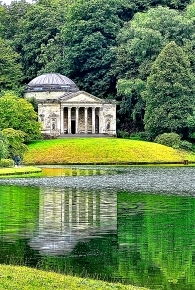
The gardens were laid out between 1741 and 1780. They were designed to resemble the arcadian scenes as portrayed in paintings by Claude Lorraine, Nicolas Poussin, and Gaspar Dughet. The designer and source of inspiration for the gardens was the banker Henry Hoare II (1705–1785), also known as ‘Henry the Magnificent’. The resulting horticultural creation is a remarkably successful realisation of what had inspired him. A central water feature – a lake – is fed by streams and rivulets. Around the lake, are a series of picturesquely positioned neo-classical pavilions, a bridge, a Tudor cottage (which existed before the garden was created), and a man-made grotto.
One of the neo-classical structures, The Pantheon (designed by Henry Flitcroft; 1697-1769 – he died in London’s Hampstead), contains a set of 18th century sculptures of Ancient Greek gods and heroes. It also contains a well-preserved Ancient Roman statue, which one of the Hoares bought while travelling in Rome. It was interesting to enter this building because on all our previous visits, it had been locked closed. Another pavilion, smaller than The Pantheon, contains a huge white vase made from Coade Stone (made from clay, quartz, and flint), which was regarded as a ‘wonder’ material by architects and designers in the 18th century. In those days, it was cheaper than most stones and timber. It is named after the businesswoman Eleanor Coade (1733-1821), who was very successful at marketing this material invented by Daniel Pincot. The reason I write about this is that currently there is a small exhibition about Eleanor Coade in the small neo-Classical pavilion that faces The Pantheon across the lake.
Even if you are unable to enter any of the pavilions surrounding the lake, a visit to Stourhead Gardens is a magical experience. Here, nature has been guided into creating the 18th century ideal of a classical landscape. It brings to life the Latin expression ‘Et in Arcadia Ego’, which means something like ‘even in Arcadia, there am I’.
July 9, 2024
A tiny chapel and a Catholic martyr both in a port in Cornwall
WHENEVER WE VISIT the picturesque port of St Ives in Cornwall, we come across things we had not noticed on previous visits. On our latest visit, made in early July 2024, we discovered a monument that we had not noticed before and entered a chapel, which we had seen often, but never entered.
The monument is a bas-relief plaque mounted on one of the walls of the Roman Catholic Sacred Heart and St Ia Church. It is dedicated to the memory of John Payne, the portreeve (harbour master) of St Ives. He was executed in 1549 because he was a Roman Catholic. His demise occurred during the 1549 Prayerbook Rebellion. In case you had never heard of this – and it was news to me – the Prayerbook Rebellion (aka the ‘Western Rising’) happened because of something that happened during the reign of King Edward VI. Edward’s uncle, Edward Seymour, encouraged iconoclasm and the use of English (instead of Latin) during church services. This was unpopular in large parts of England, and when in 1549 the “Book of Common Prayer” was introduced, revolt against it broke out in Devon and Cornwall.
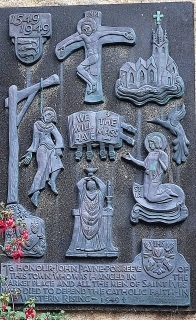
John Payne was hung in the marketplace of St Ives. His death was ordered by Sir Anthony Kingston, the Provost Marshal (c1508-1556). Payne was not the only Cornishman who was executed for his Catholic beliefs. The monument in St Ives is not only dedicated to him but also to:
“… all the men of St Ives who died to defend the Catholic faith in the Western Rising – 1549”
I am not sure when the memorial plaque was placed on the church, but it does bear the dates “1549” and “1949”.
Further into the town than the monument just described, one reaches the Smeaton Pier, where fishing boats unload the seafood, which they have caught. Wedged between a public toilet (for ‘gents’) and the small St Ives Harbour Master’s Office, there is a tiny chapel dedicated to St Leonard. This small building built with stones is entered via a few granite steps. Consisting of a small room (about 10 feet long and 6 feet wide. No one knows when it was constructed, but records indicate that it underwent some repairs in1577. The chapel was probably used by seamen setting out for sea and also provided shelter in bad weather. In 1971, the chapel was renovated and opened as a museum and a memorial to the fishermen of St Ives.
On the outside of the chapel, there is a plaque commemorating the record breaking 600-mile passage made by the St Ives lugger Lloyd from Scarborough to St Ives in 1902. The journey took 50 hours. Within the chapel, there are glass cabinets containing historical maritime items as well as old photographs and some models of sailing ships.
Although small, both the chapel and the memorial add to the fascination of the wonderful town of St Ives. In a future essay, I will tell you about some more of the things we ‘discovered’ during our latest visit to the place.
July 8, 2024
A window for Sir Francis Drake in deepest Devon
NO ONE KNOWS exactly where the Explorer and naval commander Sir Francis Drake (c1540 – 1596) was ‘buried’ at sea. What is known is that his corpse clad in armour was put into a lead coffin, and then dropped into the sea somewhere near Portobelo (now in Panama).
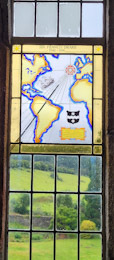
On the 400th anniversary of his death, a stained glass window which is part of a sundial was installed at the Drake family home in Devon: Buckland Abbey. The window depicts a chart of the Atlantic Ocean on which a small cross has been marked in the approximate location of Drake’s burial. The window/sundial was designed by Christopher Daniel.
July 7, 2024
Come to good in the countryside of Cornwall
QUAKERS, MEMBERS OF The Society of Friends are Christians who believe that worship should rely on the guidance of the Holy Spirit without the intercession of ordained ministers and without practising outward rituals. The Quakers worship one to one with God without any external ‘frills’. The Quaker movement was founded by George Fox (1624-1691) in about 1652.
Fox travelled around England, Europe, and North America, encouraging people to adopt his method of worship. In 1656, he came to Cornwall. While there, he was arrested for blasphemy several times. Nevertheless, many Cornish people were keen to hear what he had to say, and became his followers. Soon after his visit, groups of Quakers began to form in Cornwall. One of them began meeting in a farmhouse near to the hamlet called Come-to-Good in about 1653. Then, they began renting another building nearby. When this began to disintegrate in 1707, they raised money to build a new Meeting House: a simple thatched cottage, which was completed in about 1710. This humble edifice is still in use for worship meetings today. It stands in Come-to-Good.
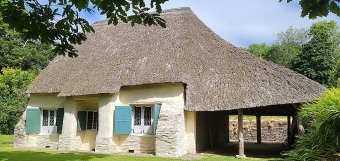
The historicengland.org.uk website noted:
“The Meeting House was built in 1710 using funds’ raised from Quaker subscribers in 1707 and 1710. … Research by Mr Withers of Penelewey Barton shows that the farm, including the land on which the meeting house stands, was owned by James Mayo, a Quaker, and was later leased to Vyvian, whose name with the date 1716 is scratched on one of the window panes at the farmhouse. In spite of the C20 porch on the west end, this little meeting house has been remarkably unaltered since the C19 and still retains much of its original character and fabric.”
We visited the Meeting House in early July 2024. Sadly, we could not enter it because it was locked up. So, we were unable to see its simple interior, which has remained almost unchanged since the place was first used. From the road, the Meeting House looks much as it would have when it was built. A small extension with an entrance hall, kitchen, and toilets was added to the rear of the old building in 1967.
There is a small Quaker burial ground near the Meeting House, but we did not notice it because the burial mounds were levelled in the 1940s. One of the people buried there is a Quaker preacher, Catherine Payton Phillips (1727-1794), who, like George Fox, travelled in the British Isles, Continental Europe, and the North American colonies. In 1772, she married William Phillips, and lived with him in his home in Redruth (not far from Come-to-Good).
As for the hamlet’s name, Come-to-Good, it is currently believed that the place was only called that after the formation of the local Quaker’s meeting group. Although it is only a small building, which hardly rivals some of Cornwall’s other attractions, it is a pleasant, peaceful place to visit in the heart of the Cornish countryside.
July 6, 2024
The Spanish in Cornwall and a nephew of Napoleon Bonaparte
THE DEFEAT OF the Spanish Armada in 1588 did not put an end to Spanish attempts to invade Britain or to terminate the reign of the Protestant Queen Elizabeth I. In summer 1593, the Spanish commander Carlos de Amésquita set sail from Brittany, and headed towards the British coast. His fleet sailed towards Cornwall because the Spanish believed that the Cornish might be likely to give up Protestantism and embrace Roman Catholicism.
In late July 1595, the Spanish fleet bombarded the tiny port of Mousehole. They burned and/or reduced to rubble almost every house in the place, and then departed. The inhabitants of the town fled for their lives.
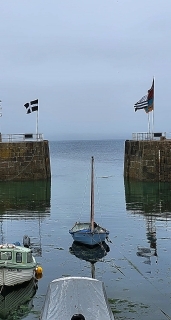
Today, the 3rd of July 2024, we visited the picturesque village of Mousehole, and came across a house named ‘Keigwin’. It has a wing that projects into the lane, and is supported by stone pillars. A plaque attached to it explains:
“Squire Jenkyn Keigwin was killed here 23rd July 1595 defending this house against the Spaniards.”
His house, which was built by the 16th century, is the only building that survived the Spanish attack on Mousehole. Jenkyn Keigwin (1531-1595) was the publican who owned the Keigwin Arms pub in Mousehole. The house that survived the Spanish attack was part of a manor house.
A few yards away from Keigwin, there is a newer, smaller house, on which we spotted another interesting plaque. It reads:
“Here lived Dolly Pentreath. One of the last speakers of the Cornish language as her native tongue, Died 1777”
Dolly was born in Mousehole, and baptised in 1692. She made a living selling fish. The lawyer and antiquarian Daines Barrington came across her when he was searching for native speakers of Cornish in 1768, and later published an account of her in his learned paper about the extinction of the Cornish language. In about 1777, the Cornish-born artist, John Opie (he became a professor at London’s Royal Academy) painted her portrait.
Dolly was buried in the churchyard at Paul (close to Mousehole). In 1860, the French philologist Louis Lucien Bonaparte (1813-1891), a nephew of Napoleon Bonaparte, set up a monument to honour Dolly. I have only seen a photograph of this. The inscription on it reads:
“Here lieth interred Dorothy Pentreath who died in 1777, said to have been the last person who conversed in the ancient Cornish, the peculiar language of this country from the earliest records till it expired in the eighteenth century, in this Parish of Saint Paul. This stone is erected by the Prince Louis Bonaparte in Union with the Revd John Garret Vicar of St Paul, June 1860. Honour thy father and thy mother, that thy days may be long in the land which the Lord thy God giveth thee. Exod. xx. 12. Gwra pethi de taz ha de mam: mal de Dythiow bethenz hyr war an tyr neb an arleth de dew ryes dees. Exod. xx. 12”
The last few words being in Cornish. I first came across Louis Bonaparte when I met Bejtullah Destani, a diplomat and scholar who researches Albanian history. When he found out that I was researching a book about the Albanian communities which have been in Sicily since the 15th century, he gave me a copy of “Albanian Dialects”, which is a collection of studies of Albanian dialects written in English by Louis Bonaparte. Although his main philological interest was the Basque language, he was also interested in Celtic languages (of which Cornish is one), as well as the dialects of Sardinia and mainland Italy. His book on Albanian dialects is mainly concerned with the numerous Albanian speaking communities in southern Italy.
Mousehole was attacked by the Spanish, but, fortunately, not by Louis Lucien Bonaparte’s uncle. However, while looking around this beautiful place today, we saw the plaque commemorating Dolly Pentreath. Only after leaving the village, I learned of its slightly tenuous connection with the Bonaparte family.
July 5, 2024
Indecision
July 4, 2024
The artist Mark Rothko in Cornwall
MANY PEOPLE MEDITATE profoundly in front of paintings by the American artist Mark Rothko (1903-1970). I am not one of those people. I can recognise his work and appreciate its originality, but he is not amongst my favourite 20th century artists.
When visiting the branch of the Tate Gallery in Cornwall’s St Ives at the beginning of July 2024, I viewed a small exhibition of painted panels created by Rothko. In 1958, he was commissioned to paint them for the Four Seasons restaurant in the Seagram Building in New York City. In the summer of 1959, he took a break from painting this series of pictures, and visited England. The painter Peter Lanyon invited Rothko to his home in St Ives in Cornwall. During his stay, he met other artists based in the West Country including Alan Davie, Paul Feiler, Patrick Heron, and Terry Frost. Rothko’s visit to St Ives was a factor that helped change his mind about displaying the paintings he was creating for the Four Seasons restaurant. It has been recorded that he said that the restaurant was:
“… a place where the richest bastards of New York will come to feed and show off.” (theartnewspaper.com, 4th of April 2024).
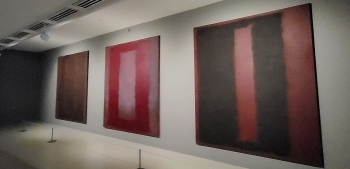
In 1969, Rothko donated nine of the paintings, originally destined for the restaurant, to the Tate Gallery. Seven others can be viewed at the Kawamura Museum of Modern Art in Japan, and another thirteen are housed at the National Gallery of Art in Washington DC. The rest are owned by his children.
Usually, the paintings currently being displayed at the Tate in St Ives are to be found in a dedicated room in London’s Tate Modern. Currently, the room where they are usually stored in Tate Modern is being used to host an exhibition by another artist (Joan Mitchell). The Seagram murals will remain in St Ives until January 2025.
We visit St Ives regularly. Its branch of the Tate is one of several artistic attractions we visit in the town. Although it contains some great artworks, I am not fond of its architecture. I am glad we visited again because had we not done so, I would not have known about Rothko’s holiday in St Ives, and the influence it had on his decision not to display his paintings in a fancy restaurant in New York City.
July 3, 2024
Indian queens in the heart of Cornwall
DURING NUMEROUS VISITS to Cornwall, we have driven along the A30 road. Often on these journeys, we have driven past signs pointing to a place named ‘Indian Queens’, but we had never visited it. So, on the 29th of June 2024, we left the main road and headed towards Indian Queens without knowing what to expect. To be honest, at first sight, the place does not seem of any interest to the visitor. But, as we were to discover, Indian Queens contains one of the most unusual sights in Cornwall.
By chance, we pulled up opposite a house, which incorporates two granite pillars surmounted by a triangular pediment on which the following words are inscribed:
“THE INDIAN QUEEN. Licensed brewer and retailer of beer, cyder, spirits, wine, and tobacco. Licensed to the post horses.”
The building to which this was attached was not a pub and looked newer than the pillars and the inscribed pediment. These fragments are all that remains of a pub called ‘The Indian Queen’, which stood in another part of the district: between Goss Moor and Fraddon. The former pub, which had been built in the late 18th century, had a Victorian signboard (now in a museum in Truro). It depicted an American Indian Queen on one side and Queen Victoria on the other. Until about 1780, the pub had been called ‘The Queen’s Head’, but by 1787, it had become ‘The Indian Queen’. It is thought by some that a Portuguese princess, who was travelling between Falmouth and London, stayed at the inn, and because she was olive skinned, the locals thought she was an American Indian queen, and that is how the name of the pub and of the village originated. Later, the village name changed from Indian Queen to Indian Queens, as it is known today.
The village has one Indian restaurant, aptly named “Indian Queen”. Run by some friendly Bangladeshi people, it occupies what was formerly The Railway Tavern pub. We ate dinner there. The following morning, we returned to Indian Queens to look at something we had missed the day before. Pocohontas Crescent leads to a footpath that heads towards the Indian Queens Pit. This proved to be a most interesting place.
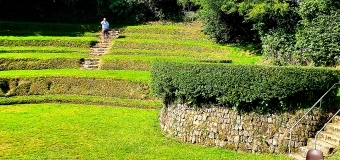
In 1850, local Wesleyans approached the mine owner Henry Jenkyn to convert the local, disused quarry into an outdoor ‘preaching pit’, like the one already created (from a disused mining quarry) at Gwennap near Redruth, which was used by John Wesley – the founder of Methodism. The preaching pits were like amphitheatres in which large numbers of people could listen to the preaching of Methodist ministers. By 1860, the pit at Indian Queens was already being used by the congregations of various local Methodist chapels. Between 1880 and 1907, the pit had been adapted to look as it does today. The sloping sides of the pit were remodelled to create tiers just like those in ancient Greek and Roman amphitheatres, but each row was separated by a much greater height than in the ancient versions. The circular tiers encircle a round, flat area below them. By 1907, the semicircular raised preaching platform was in place. The pit was used for preaching, Sunday School anniversaries, and other events until 1970.
Between 1970 and 1976, the pit became overgrown and was unused. However, in 1976, a local man, Lloyd Truscott, worked hard to restore the pit. On the 20th of May 1978, a service was conducted in the restored pit. Today, the pit is owned by a group of trustees representing the local Methodists and other organisations. It is still used for staging events, and we were lucky enough to attend one of them on the 30th of June 2024. That afternoon, we watched a highly entertaining improvised version of “Tristan and Isolde” – a play, not the opera. Three young actors performed it very engagingly and with great panache.
Until we ventured into Indian Queens, I had never heard of preaching pits. There are three surviving circular preaching pits in Cornwall, and one, which only occupies a quarter of a circle. I hope to write more on this subject at a later date.
July 2, 2024
From rural Cornwall to the Royal Academy in London
ONE OF MY FAVOURITE National Trust properties in England is Trerice, which is about 2.3 miles south of the Cornish town of Newquay – not one of my favourite places in Cornwall. We visit the house and gardens at Trerice every time we spend time in Cornwall, and always discover soothing there that we had not noticed before.
This tine (June 2024), one of the volunteers working in the house pointed out a painting by John Opie (1761-1807). I had not come across his name before. Our informant told us that he had been born in Cornwall, and thought that he had been involved with the establishment of the Royal Academy. He was born at Trevallas between St Agnes and Perranporth, both of which are not far from Trerice. At an early age, his artistic talents became evident, but his father, a carpenter, wanted John to become a carpenter. A physician, Dr Wolcot, met him at the place where he was an apprentice, and reecognising John’s artistic skills, paid for him to be released from his apprenticeship. Wolcot encouraged Opie, and by the start of the 1790s, he was a successful portraitist in Cornwall.
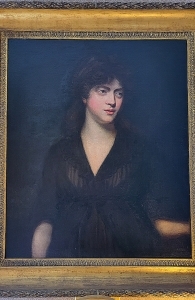
In 1781, Wolcot took Opie to London, where his works were admired by great artists of the time including Sir Joshua Reynolds, who compared John’s work to that of Caravaggio and Velasquez. A year later, Opie began working independently of Wolcot, who had been supporting him up until then. An acquaintance of Dr Wolcot introduced Opie to the court of King George III. This led to Opie being commissioned to paint portraits of people of high rank in English society and royalty. In 1886, he was elected a full member of the Royal Academy, and in 1805 he was appointed a professor in that esteemed institution.
There are three paintings by Opie hanging on the walls of Trerice house. One is a portrait, and another a self-portrait. The third, which depicts three people playing cards, is a copy of the same picture that can be seen at Petworth house. The version at Trerice is believed to have been painted by Opie and others in his studio. Each of the three people in it have smiles. It is thought that in this painting, Opie was experimenting with the depiction of smiling. Although attractive, this picture is not as attractive as his other two paintings in Trerice.
It is always pleasant to re-visit places, and always exciting to discover something one had missed on earlier trips to that same location. As well as the lovely interiors at Trerice, the gardens surrounding it are always a joy to behold.

